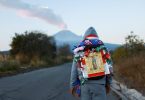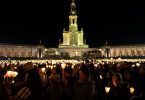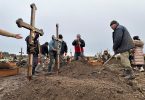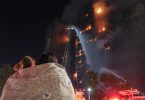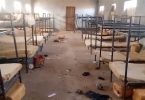by Judith Sudilovsky
JERUSALEM (CNS) — On a tidy residential street of the Christian Quarter of the Old City, boys still play with marbles along the cobblestones, and neighbors call out to one another from balconies abloom with red carnations.
Mounir Nasrawi, affectionately known by the traditional nickname Abu George, can pick up a few tomatoes for lunch from the street vendor on his way home from his grocery shop and, if he forgets his wallet, the vendor accepts a promise to pay.
But the neighborly relations end when he reaches his own front stoop and confronts the four-story, multifamily structure converted from an old single-story family home about six years ago. Jewish settlers bought it from a Catholic who lived there.
The building is among 88 locations — mainly in the Muslim Quarter, but also at least four in the Christian Quarter — that, according to statistics from the Palestine Liberation Organization Negotiations Affairs Department, have been taken over by Jewish settlers. The process began in the mid-1970s, and many see it as a decisive Israeli campaign to rid the Old City of both its Muslim and Christian Palestinian residents.
“I don’t want to exaggerate, but there is a feeling on the part of the Palestinians that the current Israeli government just wants a purely Jewish (Jerusalem),” said Sami El-Yousef, regional director for Palestine and Israel for the Catholic Near East Welfare Association-Pontifical Mission. El-Yousef, who works and lives in the Old City, said the message is, “We are moving in because we want you out.”
Some properties, like the building in front of the Nasrawis, were bought in a normal transaction, while others were bought under various false pretenses.
Aviv Tatarsky, a researcher for Ir Amim, an Israeli nonprofit organization that focuses on the Israeli-Palestinian conflict in Jerusalem, said a majority of the acquisitions were carried out through the law of absentee property, which allows Jews to claim Jewish property lost in 1948 following the establishment of the State of Israel. Palestinians do not have the same right with property lost when they were expelled from West Jerusalem.
Amnon Ramon, senior researcher at The Jerusalem Institute for Israel Studies, cautioned against terming the Old City settler movement as a unified Israeli government plan. With approximately 5,000 Jewish residents — including those living in the Jewish Quarter — among the 30,000-40,000 Palestinian inhabitants, he said, it is clear that if there were such a plan on the part of some in the government, it has failed over the past 40 years. There are only a few hundred Jews living outside the Jewish Quarter, and most of those are yeshiva students, he said.
“They clearly have government support, but to say that the Israeli government is using all its power to get the Christians and Muslims out of the Old City is exaggerated,” Ramon said. “There are also some people in the Israeli administration who are opposed to this, and the security and financial costs are difficult.”
Most of the property in the Christian Quarter belongs to the various churches, and the Nasrawis have a long-term rental arrangement with the Greek Orthodox Church for their building, where they live in their street-level apartment with two of their adult sons. Their married daughter lives in the narrow second-floor apartment with her husband and two small children.
In addition to the complaints of the crowding created by the new building, Nasrawi, 55, and his wife Ellen, 53, who are both Greek Orthodox, said they face tension and harassment from their Jewish neighbors. They said there have been numerous altercations over the years.
Nasrawi said although there have been moments of humanity and compassion — like when one of the Jewish neighbors who is a nurse rushed to the aid of a Palestinian boy who was choking — in general the settlers dislike their children playing with the neighborhood Palestinian children. They demand that the neighborhood children not play in the road in front of their building — which happens also to be in front of the Nasrawi home — and they rely on two armed security guards to escort them whenever someone leaves the building.
“Sometimes I am afraid of them because they all have guns,” said Nasrawi. “When they come out of the building, their gun is always on their hip.”
A spokesman for the Negotiation Affairs Department said that, as a result of the Jewish settlements, the main issue the Christian Quarter struggles with is the dramatic reduction of its public space. He said the main Jewish expansion in Christian neighborhoods is into the Armenian Quarter and the area around Herod’s Gate. In addition, he noted, there is settler presence in the areas of seven out of the 14 Stations of the Cross on the Via Dolorosa.
The Syriac Christian neighborhood has been the most affected by the incursion of Jewish enclaves from the Jewish Quarter and has all but disappeared as a Christian area, he added. Only the Syriac church and a couple of houses are left, he said.
“Their presence means an increase in security, which in and of itself is needless provocation, with armed escorts going up and down the streets — [and there is] the usual stuff that comes with settlers moving into the neighborhood, making it extremely uncomfortable,” said El-Yousef. “There are barriers going up, flags go up, creating unnecessary tension. There are watch towers and cameras. This is unhelpful. When you have good neighbors, no one cares. Jerusalem would be the most beautiful city on earth if people would learn how to share.”
Though friction between the settlers and their security guards and local residents is greater in the Muslim Quarter, their presence in the Christian Quarter is still a cause of consternation for the residents, said El-Yousef.
Neighbors wonder who is going to sell next and how, he said. Often the transactions of these properties are shrouded in mystery, and people become suspicious of each other, wondering which leases of homes belonging to elderly neighbors have already been transferred to settlers waiting to take over the building after their death.
“It is not just a pocket [of settlers], but a growing extension,” he said. “People begin to wonder what is planned for the future. There are a lot of unknowns.”


